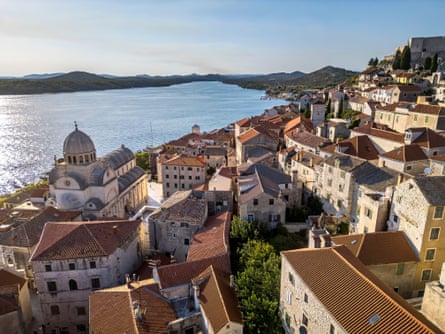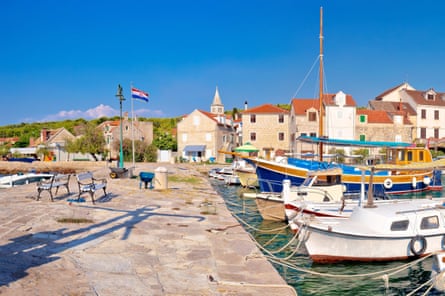This tale of two islands – and a city – was not the usual Croatian island-hopping experience, say, from Split to Hvar and Brač. I set out to enjoy a quieter, more laid-back alternative farther north, where the overlooked city of Šibenik is the jumping-off point to a very different side of the Adriatic.
First there’s Šibenik itself, which is still relatively devoid of the crowds you see in Croatia’s other coastal cities. Here you naturally gravitate towards the magnificent Unesco-listed St James Cathedral before checking out the cafe terraces on the Riva waterfront and the bars beside the fishing boats moored further up the quayside. Medieval St Michael’s Fortress and its 17th-century Venetian neighbours, St John’s and Barone, loom over the city, the latter two built to protect against Ottoman attacks. They have all been transformed into important cultural institutions – St Michael’s into an amphitheatre for concerts, St John’s an educational centre and cafe and Barone an open-air cinema with augmented-reality displays. Views of the city became even more impressive the higher I climbed to each fortress.
It was fear of the Ottoman Turks that led many Šibenčani to flee to the islands beyond St Anthony’s channel, which shelters the city from the Adriatic Sea. Nowadays, it’s a more carefree – and car-free – experience here in the Šibenik archipelago. After a night in the city, I took the 25-minute Jadrolinija ferry to Zlarin, one of the archipelago’s six inhabited islands and measuring all of 3 square miles. Zlarin village, curving round the bijou port, is the only one on the island, and cars have been banned for decades (apart from the fire brigade, the occasional builder’s van and, during our visit, a Zagreb film crew making a children’s movie). Otherwise, it’s golf buggies, bicycles and the odd scooter.
There are no hotels either, just private flats and houses whose owners wait at the jetty in their golf carts to lift you and your luggage. They included Karla and Nikša, whose airy apartment we were renting. It had a large terrace above the western side of the V-shaped bay and a tumbling garden overflowing with pomegranate, fig and olive trees. It didn’t take long to fall in love with the view of that vividly blue sea, terracotta rooftops and deep green of the Aleppo pines that cover most of the island.

When I had briefly docked here a few months ago on a sailing trip, I felt I hadn’t seen enough of either Zlarin or its tinier neighbour, Prvić. Something about these small island communities intrigued me, especially this pair with their unusual histories, natural beauty and the sort of mellow lifestyle I wanted to savour at the tail end of summer.
Zlarin had all the requisites for a lazy island escape: a little harbour with fishing boats, sailboats and speedboats, including one transporting a vital supply of Ožujsko beer. Two of Zlarin’s handful of bars were right by the jetty where the ferry and boat excursions from Šibenik docked, making the village gently fizz with daytrippers gossiping over coffee in the sunshine. Pebbly beaches ran along the eastern side of the bay, whose clear waters were 24C in September, as were those off the beach outside our flat where I had my morning swim. Those carless roads made hiking a breeze, including a 40-minute walk to the northern coast’s secluded Boci cove. And the restaurants, particularly Konoba Aldura in the port and Restoran Prslika higher up in the village, served superior seafood in suitably rustic settings of chunky wooden tables and exposed stone walls.
Along the harbour and tucked into lanes were attractive 19th-century stone houses, and it was in the 1820s home of the Croatian Coral Centre that I learned more about why Zlarin was more than just a pleasantly sleepy island. For centuries, its men had harvested red coral, providing the means to build those lovely stone houses and turning tiny Zlarin into Croatia’s biggest coral producer. But, as the imaginative multimedia displays showed, it wasn’t environmental concerns that led to the end of Zlarin’s trade in the 1970s. The Italians, the biggest buyers, had stumbled upon their own supply of coral near Sicily and business dried up.

Tourism has stepped in since then, swelling the usual population of fewer than 300 people to nearly 10 times that in high season. On this quiet September weekend, however, Zlarin was as tranquil as I’d hoped. Too soon, though, it was time to take another 25-minute ferry north to Prvić.
About a third the size of Zlarin, Prvić squeezes in two villages, Prvić Luka and Šepurine, and a population closer to 400, but there’s still room for countless olive, pomegranate and fig trees among the Aleppo pines and cypresses. When I had seen Prvić on that sailing trip, heavy rain couldn’t obscure the fact that both its villages were exceptionally pretty. More houses made of that pale Dalmatian stone, with blue, green or brown shutters, and its ports full of colourful boats. Cars aren’t allowed here either, so people buzz about on mini-tractors and three-wheeled Piaggio Apes as well as golf carts and bikes.
Our flat in Šepurine was in one of those picture-perfect, blue-shuttered houses overlooking the village square and fishing port. The nearest of the island’s many pebbly beaches was four minutes away, and there were a healthy number of bars and restaurants, including the popular Konoba Bare next door, creating a cheerful bustle.
I could see why the Šibenik nobility built their summer homes here in the 16th century, including the family of Faust Vrančić, the Croatian polymath, lexicographer, bishop and inventor who devised an early version of the parachute. There’s an interesting museum devoted to Vrančić in Prvić Luka, and on a walk in the paths behind Šepurine we could see the long-abandoned Vrančić summer home behind high fences.

Getting to know Prvić involved exploring coastal footpaths, swimming, gazing longingly at not-quite-ripe pomegranates and settling into a slow rhythm of life. In a country where emigration remains a problem, Prvić seemed to be drawing people back. Over a delicious lunch of grilled squid and octopus stew at Konoba Gingulo, which opened in July, I discovered that the chef and owner, Krešimer Kursar, had returned to the family island after 20 years of working abroad, and serves food from as many local producers as possible, including his own garden. Another Kursar, Šime, left his job as a pipe fitter in New York to open a studio to sell his own art crafted from wood.
And then there were Goran and Lenka Franić, who took us squid fishing near the uninhabited island of Tijat. As the squid stubbornly refused to bite against the backdrop of a hypnotic sunset, I heard how Goran, bass player for one of Croatia’s biggest musical stars, Oliver Dragojević, moved back to his family’s island after his boss’s untimely death six years ago. Goran rents several flats, and takes his guests out on his boat when he has time. Later, over glasses of wine and plates of homegrown food, he and Lenka lent their beautiful voices to old Dalmatian songs of love and longing, a poignant soundtrack to an odyssey I didn’t want to end.
The trip was provided by croatia.hr. B&B doubles at Heritage Hotel Life Palace in Šibenik from €95. Apartman Strikandić in Zlarin from €70, Apartments Ukić in Prvić from €98, Goran Franić’s Apartments Dupin from €100
